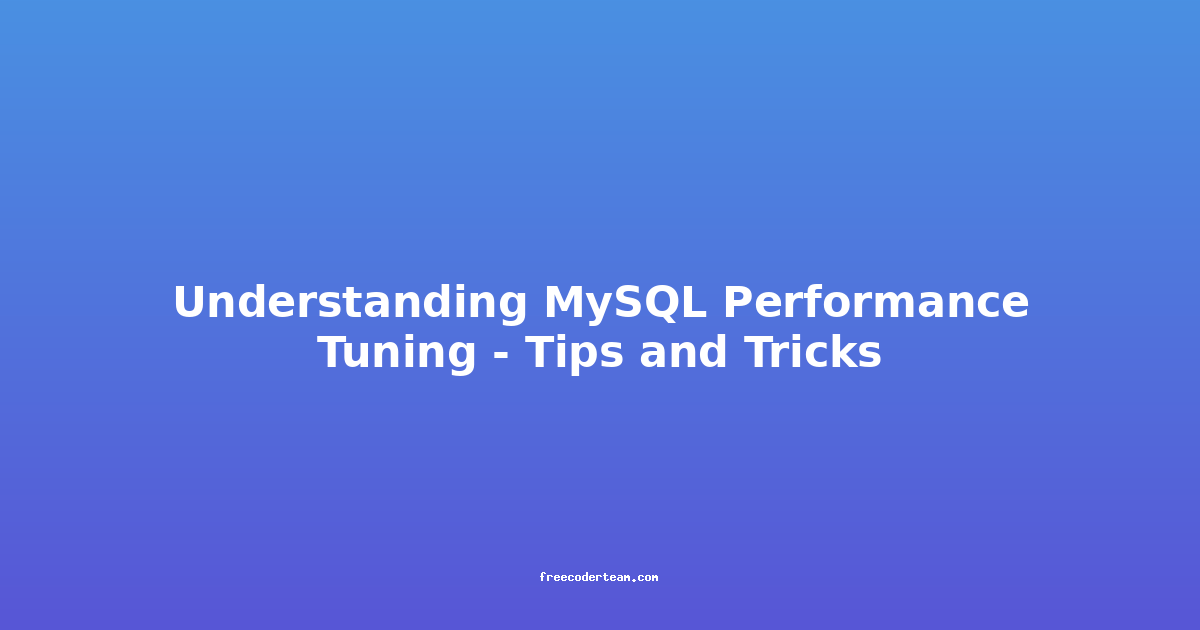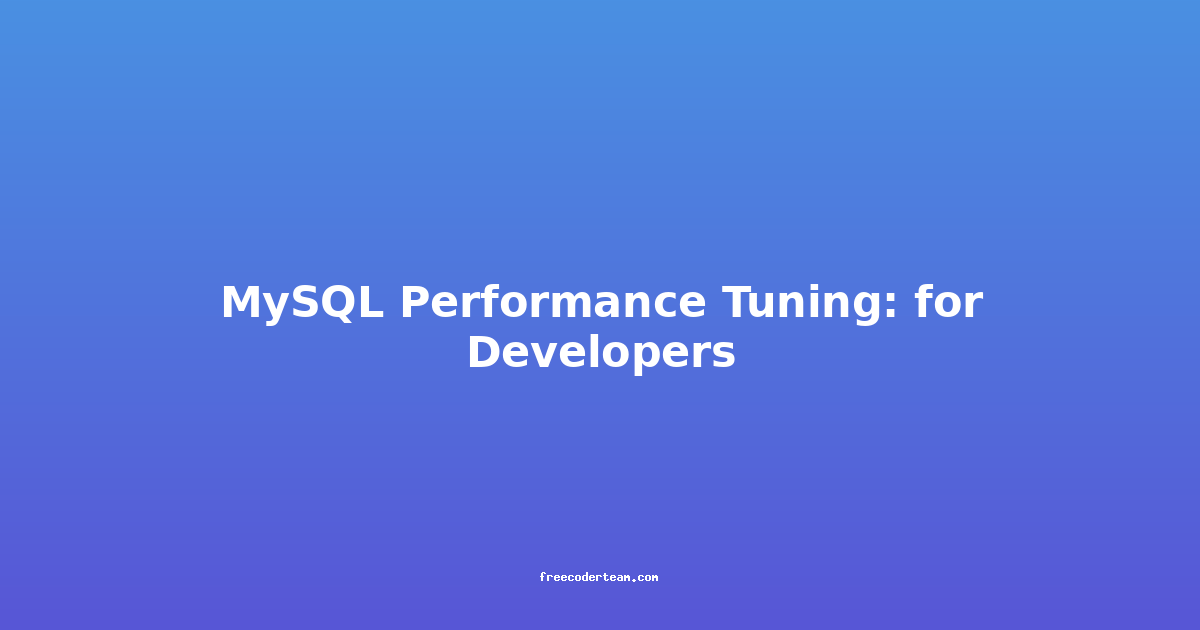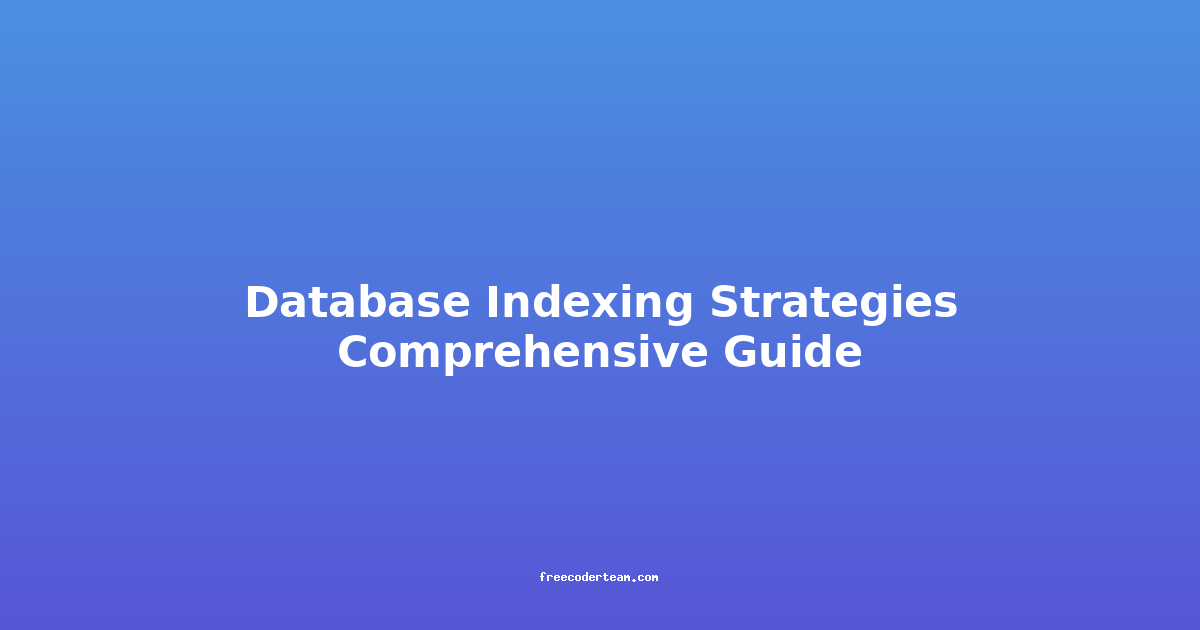Understanding MySQL Performance Tuning: Tips and Tricks
MySQL is one of the most widely used relational database management systems (RDBMS) for web applications, and its performance directly impacts the responsiveness and scalability of your application. As your application grows, so does the complexity of managing databases, making performance tuning an essential skill for database administrators and developers.
In this blog post, we'll explore key strategies for optimizing MySQL performance, including best practices, actionable insights, and practical examples. By the end, you'll have a solid understanding of how to identify and resolve performance bottlenecks in your MySQL database.
Table of Contents
- Understanding MySQL Performance Bottlenecks
- 1. Indexing Strategies
- 2. Query Optimization
- 3. Database Configuration Tuning
- 4. Storage Engine Selection
- 5. Caching Mechanisms
- 6. Monitoring and Profiling
- Conclusion
Understanding MySQL Performance Bottlenecks
Before diving into tuning strategies, it's crucial to understand common bottlenecks in MySQL performance:
- Poor Query Performance: Slow queries can overwhelm the database server, leading to increased response times and resource consumption.
- Inefficient Indexing: Missing or poorly designed indexes can force MySQL to perform full-table scans instead of using efficient index lookups.
- Suboptimal Configuration: Default settings in MySQL may not be optimized for your specific workload.
- Storage Engine Limitations: Different storage engines (e.g., InnoDB, MyISAM) have varying performance characteristics.
- Resource Constraints: Insufficient CPU, memory, or disk I/O can limit the database's ability to process queries efficiently.
To address these bottlenecks, we'll explore practical tuning techniques.
1. Indexing Strategies
Indexes are the backbone of efficient query execution in MySQL. Proper indexing can significantly reduce the time required to fetch data from large tables.
Best Practices for Indexing
- Use Primary Keys: Every table should have a primary key, which uniquely identifies each row and creates an index automatically.
- Create Secondary Indexes: Add indexes on columns frequently used in
WHERE,JOIN, orORDER BYclauses. - Avoid Overindexing: Too many indexes can slow down
INSERT,UPDATE, andDELETEoperations, as the database needs to maintain them. - Partial Indexes: For large tables, consider using partial indexes (covering indexes) that include all columns used in queries.
Example: Adding an Index
Suppose you have a users table with millions of rows and frequently query by email:
CREATE INDEX idx_email ON users(email);
This index allows MySQL to quickly locate rows based on the email column, avoiding full-table scans.
Monitoring Index Usage
Use the SHOW INDEX command to inspect existing indexes:
SHOW INDEX FROM users;
To identify unused or redundant indexes, monitor query execution plans using EXPLAIN:
EXPLAIN SELECT * FROM users WHERE email = 'john@example.com';
If the type column shows ALL or index, it indicates a full-table scan or inefficient index usage.
2. Query Optimization
Optimizing queries is a critical step in improving MySQL performance. Poorly written queries can lead to inefficient resource usage and slow response times.
Best Practices for Query Optimization
- Use Explain Plan: Analyze query execution using
EXPLAINto identify bottlenecks. - **Avoid SELECT ***: Instead, explicitly select only the columns you need to reduce the data transfer load.
- Limit Result Sets: Use
LIMITto restrict the number of rows returned, especially for paginated results. - Optimize JOINs: Ensure that JOIN operations are efficient by indexing joined columns and using appropriate JOIN types.
- Avoid Functions in WHERE Clauses: Functions on indexed columns can prevent the use of indexes.
Example: Optimizing a Query
Consider the following slow query:
SELECT * FROM orders WHERE order_date = '2023-10-01';
If order_date is not indexed, MySQL will perform a full-table scan. To optimize this, create an index:
CREATE INDEX idx_order_date ON orders(order_date);
Then rewrite the query to select only the necessary columns:
SELECT order_id, customer_id, total_amount
FROM orders
WHERE order_date = '2023-10-01';
Using Query Cache
MySQL's query cache stores the results of SELECT queries to reduce the load on the database. However, it's disabled by default in recent versions. If enabled, use it judiciously:
SET GLOBAL query_cache_size = 16777216; -- 16MB
SET GLOBAL query_cache_type = 1; -- Enable query cache
3. Database Configuration Tuning
MySQL's performance can be significantly improved by fine-tuning its configuration settings. The default settings are often conservative and may not suit your workload.
Key Configuration Parameters
innodb_buffer_pool_size: Controls the size of the buffer pool used by InnoDB for caching data and indexes. Set it to 70-80% of your server's memory for optimal performance.query_cache_size: Adjust the size of the query cache based on your workload. Disable it if you're using a version of MySQL where it's deprecated.innodb_flush_method: Set toO_DIRECTto bypass the filesystem cache, which can improve write performance.innodb_log_file_size: Increase the size of the log files to reduce the frequency of log flushes, improving transaction performance.
Example: Tuning my.cnf
Here's an example of a custom my.cnf configuration for a high-performance server:
[mysqld]
innodb_buffer_pool_size = 8G
innodb_log_file_size = 2G
innodb_flush_method = O_DIRECT
query_cache_size = 0
max_connections = 500
Dynamic Variable Changes
Some variables can be modified dynamically without restarting the MySQL server:
SET GLOBAL innodb_buffer_pool_size = 8192 * 1024 * 1024; -- 8GB
SET GLOBAL max_connections = 500;
4. Storage Engine Selection
MySQL supports multiple storage engines, each with its own strengths and weaknesses. Choosing the right engine for your workload is crucial for performance.
InnoDB vs. MyISAM
- InnoDB: Supports transactions, row-level locking, and foreign keys. It's the default and recommended engine for most applications due to its ACID compliance and crash recovery capabilities.
- MyISAM: Offers better read performance but lacks transaction support. It's suitable for read-heavy workloads where transactions are not required.
Example: Choosing a Storage Engine
For a financial application requiring transactional integrity, use InnoDB:
CREATE TABLE transactions (
id INT AUTO_INCREMENT PRIMARY KEY,
account_id INT,
amount DECIMAL(10, 2),
transaction_date DATETIME
) ENGINE=InnoDB;
For a static website with read-heavy queries, MyISAM might be suitable:
CREATE TABLE blog_posts (
id INT AUTO_INCREMENT PRIMARY KEY,
title VARCHAR(255),
content TEXT,
created_at DATETIME
) ENGINE=MyISAM;
Switching Storage Engines
To change the storage engine of an existing table:
ALTER TABLE transactions ENGINE=InnoDB;
5. Caching Mechanisms
Caching can significantly reduce the load on your database by storing frequently accessed data in memory. MySQL offers built-in caching, but external caching solutions like Redis or Memcached are often preferred for larger workloads.
MySQL Query Cache
While MySQL's query cache can be useful, it has limitations, especially with write-heavy workloads. In many recent versions, it's deprecated in favor of more advanced caching solutions.
External Caching
External caching solutions like Redis can be integrated with MySQL to cache results of complex queries. For example:
-- Query to fetch user details
SELECT * FROM users WHERE id = 123;
Cache the result in Redis:
import redis
# Connect to Redis
r = redis.Redis(host='localhost', port=6379, db=0)
# Cache key
key = f"user_details:{user_id}"
# Check if data is cached
cached_data = r.get(key)
if cached_data:
return cached_data
else:
# Fetch from MySQL
user = fetch_user_from_mysql(user_id)
# Cache the result
r.set(key, user, ex=3600) # Cache for 1 hour
return user
Benefits of External Caching
- Reduced Load: Caches handle frequent read operations, reducing the number of queries MySQL needs to process.
- Scalability: Distributed caching solutions like Redis can scale horizontally.
6. Monitoring and Profiling
Monitoring MySQL performance is essential to identify bottlenecks and validate the effectiveness of your tuning efforts.
Tools for Monitoring
-
Slow Query Log: Enable the slow query log to capture queries taking longer than a specified threshold:
SET GLOBAL slow_query_log = 1; SET GLOBAL long_query_time = 1; -- Log queries taking > 1 secondThe log is stored in a file (e.g.,
slow-query.log), which you can analyze using tools likemysqldumpslow. -
Performance Schema: MySQL's built-in performance schema provides metrics on query execution, table access, and resource usage:
SELECT * FROM performance_schema.events_statements_summary_by_digest ORDER BY total_latency DESC LIMIT 10; -
Third-Party Tools: Tools like
pt-query-digest(from Percona Toolkit) and Grafana can provide deeper insights into performance.
Example: Analyzing the Slow Query Log
To analyze the slow query log:
mysqldumpslow -s c /var/log/mysql/slow-query.log
This command sorts queries by their count (-s c) and provides a summary of the most frequent slow queries.
Conclusion
Optimizing MySQL performance is a continuous process that requires a combination of indexing, query optimization, configuration tuning, and monitoring. By following best practices and leveraging tools and strategies outlined in this post, you can significantly improve the responsiveness and scalability of your database.
Remember:
- Index wisely: Use indexes to speed up queries but avoid overindexing.
- Optimize queries: Write efficient queries and monitor their execution plans.
- Tune configurations: Customize MySQL settings to match your workload.
- Choose the right storage engine: Select the storage engine that best fits your use case.
- Leverage caching: Use external caching to reduce database load.
By applying these techniques, you can ensure that your MySQL database remains a robust and high-performing component of your application stack. Happy tuning!
Feel free to explore and experiment with these strategies to unlock the full potential of your MySQL database.




